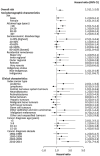Psychiatric disorders in childhood cancer survivors: A retrospective matched cohort study of inpatient hospitalisations and community-based mental health services utilisation in Western Australia
- PMID: 38404162
- PMCID: PMC11128143
- DOI: 10.1177/00048674241233871
Psychiatric disorders in childhood cancer survivors: A retrospective matched cohort study of inpatient hospitalisations and community-based mental health services utilisation in Western Australia
Abstract
Objective: We examined the impact of long-term mental health outcomes on healthcare services utilisation among childhood cancer survivors in Western Australia using linked hospitalisations and community-based mental healthcare records from 1987 to 2019.
Method: The study cohort included 2977 childhood cancer survivors diagnosed with cancer at age < 18 years in Western Australia from 1982 to 2014 and a matched non-cancer control group of 24,994 individuals. Adjusted hazard ratios of recurrent events were estimated using the Andersen-Gill model. The cumulative burden of events over time was assessed using the method of mean cumulative count. The annual percentage change in events was estimated using the negative binomial regression model.
Results: The results showed higher community-based service contacts (rate/100 person-years: 30.2, 95% confidence interval = [29.7-30.7] vs 22.8, 95% confidence interval = [22.6-22.9]) and hospitalisations (rate/1000 person-years: 14.8, 95% confidence interval = [13.6-16.0] vs 12.7, 95% confidence interval = [12.3-13.1]) in childhood cancer survivors compared to the control group. Childhood cancer survivors had a significantly higher risk of any event (adjusted hazard ratio = 1.5, 95% confidence interval = [1.1-2.0]). The cumulative burden of events increased with time since diagnosis and across age groups. The annual percentage change for hospitalisations and service contacts significantly increased over time (p < 0.05). Substance abuse was the leading cause of hospitalisations, while mood/affective and anxiety disorders were common causes of service contacts. Risk factors associated with increased service events included cancer diagnosis at age < 5 years, leukaemia diagnosis, high socioeconomic deprivation, and an attained age of < 18 years.
Conclusions: The elevated utilisation of healthcare services observed among childhood cancer survivors emphasises the need for periodic assessment of psychiatric disorders, particularly in high-risk survivors, to facilitate early management and optimise healthcare resources.
Keywords: Cancer survivors; adolescence cancer; health service utilisation; mental disorders; paediatric cancer.
Conflict of interest statement
Declaration of Conflicting InterestsThe author(s) declared no potential conflicts of interest with respect to the research, authorship, and/or publication of this article.
Figures


Similar articles
-
Hospitalizations and Cost of Inpatient Care for Physical Diseases in Survivors of Childhood Cancer in Western Australia: A Longitudinal Matched Cohort Study.Cancer Epidemiol Biomarkers Prev. 2023 Sep 1;32(9):1249-1259. doi: 10.1158/1055-9965.EPI-22-1313. Cancer Epidemiol Biomarkers Prev. 2023. PMID: 37409970
-
Adverse mental health outcomes in a population-based cohort of survivors of childhood cancer.Cancer. 2018 May 1;124(9):2045-2057. doi: 10.1002/cncr.31279. Epub 2018 Feb 22. Cancer. 2018. PMID: 29468664
-
Psychiatric disorders in childhood cancer survivors in Denmark, Finland, and Sweden: a register-based cohort study from the SALiCCS research programme.Lancet Psychiatry. 2022 Jan;9(1):35-45. doi: 10.1016/S2215-0366(21)00387-4. Epub 2021 Nov 22. Lancet Psychiatry. 2022. PMID: 34822758
-
A follow-up study of mental health service utilisation in a cohort of 2433 sexually abused Australian children utilising five years of medical data.Child Abuse Negl. 2019 Apr;90:174-184. doi: 10.1016/j.chiabu.2019.01.015. Epub 2019 Feb 22. Child Abuse Negl. 2019. PMID: 30798015
-
Psychiatric Disorders in Adolescent and Young Adult-Onset Cancer Survivors: A Systematic Review and Meta-Analysis.J Adolesc Young Adult Oncol. 2020 Feb;9(1):12-22. doi: 10.1089/jayao.2019.0097. Epub 2019 Dec 12. J Adolesc Young Adult Oncol. 2020. PMID: 31674879
Cited by
-
Psychiatric disorders in adolescent and young adult cancer survivors in Korea.ESMO Open. 2025 Feb;10(2):104101. doi: 10.1016/j.esmoop.2024.104101. Epub 2025 Jan 27. ESMO Open. 2025. PMID: 39874901 Free PMC article.
-
Suicide and Suicidal Ideation Among Survivors of Childhood Cancer: A Systematic Review and Meta-Analysis.JAMA Netw Open. 2025 Feb 3;8(2):e2457544. doi: 10.1001/jamanetworkopen.2024.57544. JAMA Netw Open. 2025. PMID: 39960673 Free PMC article.
References
-
- Abadie A, Massoubre C, Casagranda L, et al.. (2020) Prevalence of psychiatric complications in young adults after childhood cancer treatment: Results of the long-term follow-up studies in oncology. Journal of Adolescent and Young Adult Oncology 9: 247–255. - PubMed
-
- Ahomaki R, Gunn ME, Madanat-Harjuoja LM, et al.. (2015) Late psychiatric morbidity in survivors of cancer at a young age: A nationwide registry-based study. International Journal of Cancer 137: 183–192. - PubMed
-
- Australian Bureau of Statistics (ABS) (2018. a) Australian Statistical Geography Standard (ASGS) Volume 5 – Remoteness Structure, July 2016. Accessed February 23, 2021. Available at: www.abs.gov.au/AUSSTATS/abs@.nsf/Lookup/1270.0.55.005Explanatory%20Notes...
-
- Australian Bureau of Statistics (ABS) (2018. b) Technical Paper: Socio-Economic Indexes for Areas (SEIFA) 2016. Accessed February 23, 2021. Available at: www.ausstats.abs.gov.au/ausstats/subscriber.nsf/0/756EE3DBEFA869EFCA2582...
MeSH terms
LinkOut - more resources
Full Text Sources
Medical

